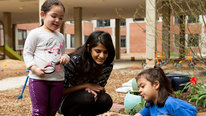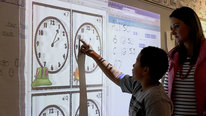- Marcia linn
- http://wise-research.berkeley.edu/mclinn
- Professor
- Presenter’s NSFRESOURCECENTERS
- UC Berkeley, Educational Testing Service
- Sarah Bichler
- Post-Doctoral Researcher
- Presenter’s NSFRESOURCECENTERS
- UC Berkeley
- Kelly Billings
- Graduate Student Researcher
- Presenter’s NSFRESOURCECENTERS
- UC Berkeley
- Allison Bradford
- Graduate Student Researcher
- Presenter’s NSFRESOURCECENTERS
- UC Berkeley
- Libby Gerard
- https://gse.berkeley.edu/libby-gerard
- Researcher
- Presenter’s NSFRESOURCECENTERS
- UC Berkeley
- Weiying Li
- Graduate Student Researcher
- Presenter’s NSFRESOURCECENTERS
- UC Berkeley
- Jonathan Lim-Breitbart
- Designer and Developer
- Presenter’s NSFRESOURCECENTERS
- UC Berkeley
- Ken Steimel
- https://steimel.info
- Assistant Research Engineer
- Presenter’s NSFRESOURCECENTERS
- Educational Testing Service
Choice
Natural Language Processing Technologies to Inform Practices in Science (TIPS)
NSF Awards: 2101669
2022 (see original presentation & discussion)
Grades 6-8, Grades 9-12
Middle school science teachers want technology to amplify their impact on the hundreds of students with multiple, diverse ideas in their classes. By exploiting advances in natural language processing (NLP) this project detects the rich ideas that students develop during everyday experience. Aligned with the Knowledge Integration pedagogy, this project takes advantage of NLP methods for detecting student ideas and creates adaptive guidance that gets each student started on reconsidering their own ideas, considering their peers’ ideas, and developing more coherent explanations for complex scientific phenomena. This work continues a successful partnership between University of California, Berkeley, Educational Testing Service (ETS), and science teachers and paraprofessionals from six middle schools enrolling students from diverse racial, ethnic, and linguistic groups whose cultural experiences may be neglected in science instruction. The idea detection technology adapts to each student's cultural and linguistic entry points into the topic. Our video illustrates how TIPS empowers students to use their ideas as a starting point for deepening science understanding.
Related Content for Adaptive Dialog: Teachers & Students Deepen Science Ideas
-
 2016Data Exploration Technology Comes to Classrooms via CODAP
2016Data Exploration Technology Comes to Classrooms via CODAP
William Finzer
-
 2015MathSpring: An Online Tutor that Personalizes Math Tutoring
2015MathSpring: An Online Tutor that Personalizes Math Tutoring
Beverly Woolf
-
 2015Automated Guidance in WISE
2015Automated Guidance in WISE
Marcia Linn
-
 2015Remote Labs - A Lab in Every Pocket
2015Remote Labs - A Lab in Every Pocket
Kemi Jona
-
 2016The Power of Project-Based Inquiry Science CyberPD
2016The Power of Project-Based Inquiry Science CyberPD
Barbara Zahm
-
 2016Mobile Response System: Interactive Problem Solving
2016Mobile Response System: Interactive Problem Solving
Mohammad Muztaba Fuad
-
 2016SimScientists Human Body Systems
2016SimScientists Human Body Systems
Daniel Brenner
-
 2016Fostering Ecologies of Online Learners
2016Fostering Ecologies of Online Learners
Marcela Borge
Playlist: DRK-12 Videos Playlist 2022
-
 2022Supports for Sustaining Professional Development Outcomes
2022Supports for Sustaining Professional Development Outcomes
Cathy Ringstaff
-
 2022Innovate to Mitigate: Environmental Innovation Challenges
2022Innovate to Mitigate: Environmental Innovation Challenges
Gillian Puttick
-
 2022Adaptive Dialog: Teachers & Students Deepen Science Ideas
2022Adaptive Dialog: Teachers & Students Deepen Science Ideas
Marcia linn
-
 2022Inquiry-to-Action through Project-Based Inquiry (PBI) Global
2022Inquiry-to-Action through Project-Based Inquiry (PBI) Global
Hiller Spires
-
 2022Impact Study: STEM-Innovation and Design (STEM-ID) Courses
2022Impact Study: STEM-Innovation and Design (STEM-ID) Courses
Meltem Alemdar
-
 2022Exploring Virtual Reality with Secondary STEM Teachers
2022Exploring Virtual Reality with Secondary STEM Teachers
Nastassia Jones
-
 2022STEM Teaching in Rural Areas with Cultural Knowledge Systems
2022STEM Teaching in Rural Areas with Cultural Knowledge Systems
Lynda McGilvary
-
 2022Teachers' Culturally Relevant Engineering Self-Efficacy
2022Teachers' Culturally Relevant Engineering Self-Efficacy
Julie Robinson
-
 2022MindHive: Citizen Science in the High School Classroom
2022MindHive: Citizen Science in the High School Classroom
Lucy Yetman-Michaelson
-
 2022Rural Science Teachers Learn 3D
2022Rural Science Teachers Learn 3D
Rebecca Sansom
-
 2022The SPIRAL e-portfolio system for professional reflection
2022The SPIRAL e-portfolio system for professional reflection
Jose Felipe Martinez
-
 2022Community Science Investigations for Social Justice
2022Community Science Investigations for Social Justice
Kevin Cuff
-
 2022Empowering Teachers in the Face of COVID: A STEM PD Model
2022Empowering Teachers in the Face of COVID: A STEM PD Model
Ellen Meier
-
 2022Building Data Literacy Through the Arts
2022Building Data Literacy Through the Arts
Anna Amato
-
 2022Teaching Early Algebra through Example-Based Problem Solving
2022Teaching Early Algebra through Example-Based Problem Solving
Meixia Ding
-
 2022Language, Culture & Knowledge Building through Science
2022Language, Culture & Knowledge Building through Science
Cory Buxton
-
 2022A Study of STEM Learning Ecosystems in Maine
2022A Study of STEM Learning Ecosystems in Maine
Kelly Riedinger
-
 2022Broadening Access to Algebra: An Intervention for Grades K–2
2022Broadening Access to Algebra: An Intervention for Grades K–2
Maria Blanton
-
 2022Integrating Student Voice into Assessment Item Design
2022Integrating Student Voice into Assessment Item Design
Leanne Ketterlin Geller
-
 2022Developing, Enacting, Researching Anti-bias Math Education
2022Developing, Enacting, Researching Anti-bias Math Education
Eva Thanheiser
-
 2022Linking Science with Eng and Math across Home and School
2022Linking Science with Eng and Math across Home and School
Ximena Dominguez
-
 2022Video in the Middle: Asynchronous Online Mathematics PD
2022Video in the Middle: Asynchronous Online Mathematics PD
Angela Knotts
-
 2022Accessible Computational Thinking in Elementary Science
2022Accessible Computational Thinking in Elementary Science
Lautaro Cabrera
-
 2022Teaching Amidst Uncertainty - Project TAU
2022Teaching Amidst Uncertainty - Project TAU
Elizabeth Metts
-
 2022Ed+gineering Brings Robotics Home During COVID
2022Ed+gineering Brings Robotics Home During COVID
Jennifer Kidd
-
 2022Connecting Math to the Real World
2022Connecting Math to the Real World
Mathew Felton-Koestler
-
 2022The EYE Unit: Placed-based Energy Literacy
2022The EYE Unit: Placed-based Energy Literacy
Laura Zangori
-
 2022Multilingual Learners and Elementary Science Achievement:
2022Multilingual Learners and Elementary Science Achievement:
F. Chris Curran
-
 2022STEM SEALs: Building an Evidence Base and Seeding Transforma
2022STEM SEALs: Building an Evidence Base and Seeding Transforma
Adrienne Smith
-
 2022Biologically Inspired Design: Teacher PD at Zoos and Gardens
2022Biologically Inspired Design: Teacher PD at Zoos and Gardens
Michael Helms
-
 2022Advance equity & strengthen teaching through math modeling
2022Advance equity & strengthen teaching through math modeling
Erin Turner
-
 2022Teacher Learning for Citizen Science
2022Teacher Learning for Citizen Science
Patrick Smith
-
 2022Integrating Data & Modeling for Science Learning in School
2022Integrating Data & Modeling for Science Learning in School
Aditi Wagh
-
 2022Misconceptions: From Roadblocks to Stepping Stones
2022Misconceptions: From Roadblocks to Stepping Stones
Susan Sunbury
-
 2022Integrating Environmental Restoration with Computer Science
2022Integrating Environmental Restoration with Computer Science
Dr. Lauren Birney
-
 2022Critical and Cultural Approaches to K-6 Science
2022Critical and Cultural Approaches to K-6 Science
JESSICA THOMPSON
-
 2022StoryMaker: Scaling STEM Inquiry Through Youth Media
2022StoryMaker: Scaling STEM Inquiry Through Youth Media
Leah Clapman
-
 2022Engaging young scientists in publication of their science
2022Engaging young scientists in publication of their science
Sarah Fankhauser
-
 2022STEAM Your Way to College
2022STEAM Your Way to College
Shakhnoza Kayumova
-
 2022Studying Mathematical Teacher Noticing with 360 Video
2022Studying Mathematical Teacher Noticing with 360 Video
Karl Kosko
-
 2022Reaching Across the Hallway
2022Reaching Across the Hallway
Rebecca Dovi
-
 2022MC2: Synthesizing Key Ideas about Collaborative Learning
2022MC2: Synthesizing Key Ideas about Collaborative Learning
Dalila Dragnic-Cindric








Catherine McCulloch
Senior Project Director
Hello Marcia and team! This is fascinating work. I would love to know more about so many aspects of it. For instance, would you say more about how this web-based system helps students consider their peers' ideas?
Allison Bradford
Graduate Student Researcher
Hi Catherine! Thank you for your question. As we further develop the NLP techniques that detect the ideas expressed in each student response, we hope to use the technology to dynamically partner students. For example, this would enable us to automatically pair students who express different ideas about a phenomenon and use the Thought Buddy to scaffold a discussion where the students consider each other's ideas. While we our still in early stages of this project, we are leveraging our partner teachers' insights about how to engage students with their peers' ideas. For example, they have suggested having students compare the prompts they received from the Thought Buddy or displaying interesting chat examples to prompt whole class discussion.
Allison Bradford
Graduate Student Researcher
We welcome your insight into these questions and any other comments or questions you have for our team!Mike Szydlowski
K-12 Science Coordinator
I love this idea and want to try it! Like any good program or idea, this takes time. What would you say that the teachers gave up to spend more time on this process? Do they feel it was a good trade off?
David Campbell
Program Officer, retired
Hi Marcia and team! I loved hearing the students say they didn't have to worry about "being wrong." It seems the thought buddy removes some of the peer pressure students face in the classroom. Following up on Mike's question, many teachers feel they face conflicting challenges of "covering the material" and taking the time of take advantage of students' individual ideas. I wonder if your teacher participants expressed that concern.
Sarah Bichler
Post-Doctoral Researcher
Hi Mike and David,
thanks for your interest and this important question. Teachers I worked with definitely expressed the concern not being able to cover the material - when trying to let students explore more, bringing in students' ideas, letting students revise, etc. With respect to the dialog, teachers really appreciated that each student was able to discuss with the avatar and that each student got unique feedback, something they could not have done in the time the chat took. I have seen teachers weave in students' ideas to jump-start a class discussion, it did not take long at all :). We hope that the dialog makes many ideas visible, placing them for being taken up beyond the chat and working with teachers to find ways in which students' ideas can become central to instruction and ways in which these ideas can help to "cover the material".
Amy Robertson
This is so cool, y'all! I have so many thoughts bubbling up. As someone who deeply values responsive teaching -- particularly responsive teaching that attends closely to the *substance* of students' thinking -- I've been somewhat skeptical of NLP because it feels like it can miss some of the depth and connections within student ideas. BUT some folks on our team just did an analysis of student responses using SLP and found that with a little bit of additional work on the part of analysts (looking at some of the top example responses), they could identify many of the same patterns that another team of researchers did without NLP. So in this case, NLP was a really helpful tool.
I'm processing out loud a bit, but I'm curious about the trade-offs you see along the lines of being able to discern and respond to substance... And we'd love to chat with you offline sometime. We share a deep value in framing students' ideas as generative and finding ways to build from there.
Sarah Bichler
Post-Doctoral Researcher
Hi Amy, thanks so much for stopping by!
I love these thoughts bubbling up! I feel if the human coding pays attention to the depth and connections within student ideas, the machine is likely to pick it up. We refine our coding multiple times and go through a rigorous training procedure before coding or annotating our training data. Our results show that if the model can detect an idea, it actually does it very well (accurate and is sensitive to the idea). We were more worried about the infrequent ideas, that we don't find ways to make these visible, an area we are still working on.
With respect to your question, I feel there are trade-offs responding to different ideas students express. If a student has multiple ideas, which one do we respond to and why? We don't know yet what's most effective. For example, a student thinks that a metal bowl conducts cold faster than a wood bowl. I see two productive ideas. The student could explore the idea of "cold flow" more, investigate, and develop it. Or, the student could expand and build on the idea of the different rates of thermal conductivity...
I'd love to talk more!
Sarah
Amy Robertson
Ann Podleski
I think this type of tool has a lot of potential for some students. And every different "tool" for engaging and promoting student reflection and thinking is helpful for teachers. The fact that students can "ask anything" and not worry about what the teacher might think is one of the benefits I can see for this. Nothing should totally replace the "human" interaction, but I can see this enhancing learning and teaching and allow for teacher's time to be used in the ways that are most effective for each different student. And I think there are clear trade-offs, but each additional venue we provide is a plus. Thanks for this work!
Sarah Bichler
Post-Doctoral Researcher
Hi Ann,
thanks so much for sharing your thoughts with us! I speak for our entire team when I say I absolutely agree with you that no technology should replace the teacher, nor would it ever be able to do that. We are working closely with teachers to learn how these tools best support them in their practice and to refine the tools we design such that we can maximize their value for practice. The potential of such tools might be that they help us scale what effective teachers do anyways. When teachers are facing many demands on different levels of teaching, such tools might help them provide the support to their students they would like to.
Best,
Sarah
Ann Podleski
Ann Podleski
Totally agree - anything that can help teachers provide support to students is a plus!!! (And I don't know if this has the option for the teacher to look at what students are saying - again that would take time, but asynchronous, which is helpful. Also, the more I can see what students are thinking, the better I can help all students.
Sarah Bichler
Post-Doctoral Researcher
Hi Ann, thanks for keeping the conversation going! Yes, teachers can see the entire dialog students had with the avatar in their WISE teacher tools view. They can see the initial explanation, the adaptive feedback from the avatar and the student's response + how they revised their explanation. It does take time to go through the chats for all your students. I have seen a teacher look at some of them to get a better sense of how students are thinking about the science between class periods or at the end of the school day. It's kinda fun reading through. Other teachers looked at what specific students had said to see if these students needed guidance or not. Yet another teacher printed the chats and used them for discussion in the class! We're also thinking about using these chats during PD when teachers have time to really dive in and explore their students' ideas. But, as you're saying, it does take time!
Further posting is closed as the event has ended.